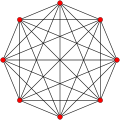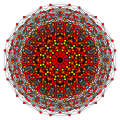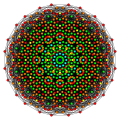| B7 uniform polytopes |
|---|
| # | Coxeter-Dynkin diagram
t-notation | Name (BSA) | Base point | Element counts |
|---|
| 6 | 5 | 4 | 3 | 2 | 1 | 0 |
|---|
| 1 |             
t0{3,3,3,3,3,4} | 7-orthoplex (zee) | (0,0,0,0,0,0,1)√2 | 128 | 448 | 672 | 560 | 280 | 84 | 14 |
|---|
| 2 |             
t1{3,3,3,3,3,4} | Rectified 7-orthoplex (rez) | (0,0,0,0,0,1,1)√2 | 142 | 1344 | 3360 | 3920 | 2520 | 840 | 84 |
|---|
| 3 |             
t2{3,3,3,3,3,4} | Birectified 7-orthoplex (barz) | (0,0,0,0,1,1,1)√2 | 142 | 1428 | 6048 | 10640 | 8960 | 3360 | 280 |
|---|
| 4 |             
t3{4,3,3,3,3,3} | Trirectified 7-cube (sez) | (0,0,0,1,1,1,1)√2 | 142 | 1428 | 6328 | 14560 | 15680 | 6720 | 560 |
|---|
| 5 |             
t2{4,3,3,3,3,3} | Birectified 7-cube (bersa) | (0,0,1,1,1,1,1)√2 | 142 | 1428 | 5656 | 11760 | 13440 | 6720 | 672 |
|---|
| 6 |             
t1{4,3,3,3,3,3} | Rectified 7-cube (rasa) | (0,1,1,1,1,1,1)√2 | 142 | 980 | 2968 | 5040 | 5152 | 2688 | 448 |
|---|
| 7 |             
t0{4,3,3,3,3,3} | 7-cube (hept) | (0,0,0,0,0,0,0)√2 + (1,1,1,1,1,1,1) | 14 | 84 | 280 | 560 | 672 | 448 | 128 |
|---|
| 8 |             
t0,1{3,3,3,3,3,4} | Truncated 7-orthoplex (Taz) | (0,0,0,0,0,1,2)√2 | 142 | 1344 | 3360 | 4760 | 2520 | 924 | 168 |
|---|
| 9 |             
t0,2{3,3,3,3,3,4} | Cantellated 7-orthoplex (Sarz) | (0,0,0,0,1,1,2)√2 | 226 | 4200 | 15456 | 24080 | 19320 | 7560 | 840 |
|---|
| 10 |             
t1,2{3,3,3,3,3,4} | Bitruncated 7-orthoplex (Botaz) | (0,0,0,0,1,2,2)√2 | | | | | | 4200 | 840 |
|---|
| 11 |             
t0,3{3,3,3,3,3,4} | Runcinated 7-orthoplex (Spaz) | (0,0,0,1,1,1,2)√2 | | | | | | 23520 | 2240 |
|---|
| 12 |             
t1,3{3,3,3,3,3,4} | Bicantellated 7-orthoplex (Sebraz) | (0,0,0,1,1,2,2)√2 | | | | | | 26880 | 3360 |
|---|
| 13 |             
t2,3{3,3,3,3,3,4} | Tritruncated 7-orthoplex (Totaz) | (0,0,0,1,2,2,2)√2 | | | | | | 10080 | 2240 |
|---|
| 14 |             
t0,4{3,3,3,3,3,4} | Stericated 7-orthoplex (Scaz) | (0,0,1,1,1,1,2)√2 | | | | | | 33600 | 3360 |
|---|
| 15 |             
t1,4{3,3,3,3,3,4} | Biruncinated 7-orthoplex (Sibpaz) | (0,0,1,1,1,2,2)√2 | | | | | | 60480 | 6720 |
|---|
| 16 |             
t2,4{4,3,3,3,3,3} | Tricantellated 7-cube (Strasaz) | (0,0,1,1,2,2,2)√2 | | | | | | 47040 | 6720 |
|---|
| 17 |             
t2,3{4,3,3,3,3,3} | Tritruncated 7-cube (Tatsa) | (0,0,1,2,2,2,2)√2 | | | | | | 13440 | 3360 |
|---|
| 18 |             
t0,5{3,3,3,3,3,4} | Pentellated 7-orthoplex (Staz) | (0,1,1,1,1,1,2)√2 | | | | | | 20160 | 2688 |
|---|
| 19 |             
t1,5{4,3,3,3,3,3} | Bistericated 7-cube (Sabcosaz) | (0,1,1,1,1,2,2)√2 | | | | | | 53760 | 6720 |
|---|
| 20 |             
t1,4{4,3,3,3,3,3} | Biruncinated 7-cube (Sibposa) | (0,1,1,1,2,2,2)√2 | | | | | | 67200 | 8960 |
|---|
| 21 |             
t1,3{4,3,3,3,3,3} | Bicantellated 7-cube (Sibrosa) | (0,1,1,2,2,2,2)√2 | | | | | | 40320 | 6720 |
|---|
| 22 |             
t1,2{4,3,3,3,3,3} | Bitruncated 7-cube (Betsa) | (0,1,2,2,2,2,2)√2 | | | | | | 9408 | 2688 |
|---|
| 23 |             
t0,6{4,3,3,3,3,3} | Hexicated 7-cube (Supposaz) | (0,0,0,0,0,0,1)√2 + (1,1,1,1,1,1,1) | | | | | | 5376 | 896 |
|---|
| 24 |             
t0,5{4,3,3,3,3,3} | Pentellated 7-cube (Stesa) | (0,0,0,0,0,1,1)√2 + (1,1,1,1,1,1,1) | | | | | | 20160 | 2688 |
|---|
| 25 |             
t0,4{4,3,3,3,3,3} | Stericated 7-cube (Scosa) | (0,0,0,0,1,1,1)√2 + (1,1,1,1,1,1,1) | | | | | | 35840 | 4480 |
|---|
| 26 |             
t0,3{4,3,3,3,3,3} | Runcinated 7-cube (Spesa) | (0,0,0,1,1,1,1)√2 + (1,1,1,1,1,1,1) | | | | | | 33600 | 4480 |
|---|
| 27 |             
t0,2{4,3,3,3,3,3} | Cantellated 7-cube (Sersa) | (0,0,1,1,1,1,1)√2 + (1,1,1,1,1,1,1) | | | | | | 16128 | 2688 |
|---|
| 28 |             
t0,1{4,3,3,3,3,3} | Truncated 7-cube (Tasa) | (0,1,1,1,1,1,1)√2 + (1,1,1,1,1,1,1) | 142 | 980 | 2968 | 5040 | 5152 | 3136 | 896 |
|---|
| 29 |             
t0,1,2{3,3,3,3,3,4} | Cantitruncated 7-orthoplex (Garz) | (0,1,2,3,3,3,3)√2 | | | | | | 8400 | 1680 |
|---|
| 30 |             
t0,1,3{3,3,3,3,3,4} | Runcitruncated 7-orthoplex (Potaz) | (0,1,2,2,3,3,3)√2 | | | | | | 50400 | 6720 |
|---|
| 31 |             
t0,2,3{3,3,3,3,3,4} | Runcicantellated 7-orthoplex (Parz) | (0,1,1,2,3,3,3)√2 | | | | | | 33600 | 6720 |
|---|
| 32 |             
t1,2,3{3,3,3,3,3,4} | Bicantitruncated 7-orthoplex (Gebraz) | (0,0,1,2,3,3,3)√2 | | | | | | 30240 | 6720 |
|---|
| 33 |             
t0,1,4{3,3,3,3,3,4} | Steritruncated 7-orthoplex (Catz) | (0,0,1,1,1,2,3)√2 | | | | | | 107520 | 13440 |
|---|
| 34 |             
t0,2,4{3,3,3,3,3,4} | Stericantellated 7-orthoplex (Craze) | (0,0,1,1,2,2,3)√2 | | | | | | 141120 | 20160 |
|---|
| 35 |             
t1,2,4{3,3,3,3,3,4} | Biruncitruncated 7-orthoplex (Baptize) | (0,0,1,1,2,3,3)√2 | | | | | | 120960 | 20160 |
|---|
| 36 |             
t0,3,4{3,3,3,3,3,4} | Steriruncinated 7-orthoplex (Copaz) | (0,1,1,1,2,3,3)√2 | | | | | | 67200 | 13440 |
|---|
| 37 |             
t1,3,4{3,3,3,3,3,4} | Biruncicantellated 7-orthoplex (Boparz) | (0,0,1,2,2,3,3)√2 | | | | | | 100800 | 20160 |
|---|
| 38 |             
t2,3,4{4,3,3,3,3,3} | Tricantitruncated 7-cube (Gotrasaz) | (0,0,0,1,2,3,3)√2 | | | | | | 53760 | 13440 |
|---|
| 39 |             
t0,1,5{3,3,3,3,3,4} | Pentitruncated 7-orthoplex (Tetaz) | (0,1,1,1,1,2,3)√2 | | | | | | 87360 | 13440 |
|---|
| 40 |             
t0,2,5{3,3,3,3,3,4} | Penticantellated 7-orthoplex (Teroz) | (0,1,1,1,2,2,3)√2 | | | | | | 188160 | 26880 |
|---|
| 41 |             
t1,2,5{3,3,3,3,3,4} | Bisteritruncated 7-orthoplex (Boctaz) | (0,1,1,1,2,3,3)√2 | | | | | | 147840 | 26880 |
|---|
| 42 |             
t0,3,5{3,3,3,3,3,4} | Pentiruncinated 7-orthoplex (Topaz) | (0,1,1,2,2,2,3)√2 | | | | | | 174720 | 26880 |
|---|
| 43 |             
t1,3,5{4,3,3,3,3,3} | Bistericantellated 7-cube (Bacresaz) | (0,1,1,2,2,3,3)√2 | | | | | | 241920 | 40320 |
|---|
| 44 |             
t1,3,4{4,3,3,3,3,3} | Biruncicantellated 7-cube (Bopresa) | (0,1,1,2,3,3,3)√2 | | | | | | 120960 | 26880 |
|---|
| 45 |             
t0,4,5{3,3,3,3,3,4} | Pentistericated 7-orthoplex (Tocaz) | (0,1,2,2,2,2,3)√2 | | | | | | 67200 | 13440 |
|---|
| 46 |             
t1,2,5{4,3,3,3,3,3} | Bisteritruncated 7-cube (Bactasa) | (0,1,2,2,2,3,3)√2 | | | | | | 147840 | 26880 |
|---|
| 47 |             
t1,2,4{4,3,3,3,3,3} | Biruncitruncated 7-cube (Biptesa) | (0,1,2,2,3,3,3)√2 | | | | | | 134400 | 26880 |
|---|
| 48 |             
t1,2,3{4,3,3,3,3,3} | Bicantitruncated 7-cube (Gibrosa) | (0,1,2,3,3,3,3)√2 | | | | | | 47040 | 13440 |
|---|
| 49 |             
t0,1,6{3,3,3,3,3,4} | Hexitruncated 7-orthoplex (Putaz) | (0,0,0,0,0,1,2)√2 + (1,1,1,1,1,1,1) | | | | | | 29568 | 5376 |
|---|
| 50 |             
t0,2,6{3,3,3,3,3,4} | Hexicantellated 7-orthoplex (Puraz) | (0,0,0,0,1,1,2)√2 + (1,1,1,1,1,1,1) | | | | | | 94080 | 13440 |
|---|
| 51 |             
t0,4,5{4,3,3,3,3,3} | Pentistericated 7-cube (Tacosa) | (0,0,0,0,1,2,2)√2 + (1,1,1,1,1,1,1) | | | | | | 67200 | 13440 |
|---|
| 52 |             
t0,3,6{4,3,3,3,3,3} | Hexiruncinated 7-cube (Pupsez) | (0,0,0,1,1,1,2)√2 + (1,1,1,1,1,1,1) | | | | | | 134400 | 17920 |
|---|
| 53 |             
t0,3,5{4,3,3,3,3,3} | Pentiruncinated 7-cube (Tapsa) | (0,0,0,1,1,2,2)√2 + (1,1,1,1,1,1,1) | | | | | | 174720 | 26880 |
|---|
| 54 |             
t0,3,4{4,3,3,3,3,3} | Steriruncinated 7-cube (Capsa) | (0,0,0,1,2,2,2)√2 + (1,1,1,1,1,1,1) | | | | | | 80640 | 17920 |
|---|
| 55 |             
t0,2,6{4,3,3,3,3,3} | Hexicantellated 7-cube (Purosa) | (0,0,1,1,1,1,2)√2 + (1,1,1,1,1,1,1) | | | | | | 94080 | 13440 |
|---|
| 56 |             
t0,2,5{4,3,3,3,3,3} | Penticantellated 7-cube (Tersa) | (0,0,1,1,1,2,2)√2 + (1,1,1,1,1,1,1) | | | | | | 188160 | 26880 |
|---|
| 57 |             
t0,2,4{4,3,3,3,3,3} | Stericantellated 7-cube (Carsa) | (0,0,1,1,2,2,2)√2 + (1,1,1,1,1,1,1) | | | | | | 161280 | 26880 |
|---|
| 58 |             
t0,2,3{4,3,3,3,3,3} | Runcicantellated 7-cube (Parsa) | (0,0,1,2,2,2,2)√2 + (1,1,1,1,1,1,1) | | | | | | 53760 | 13440 |
|---|
| 59 |             
t0,1,6{4,3,3,3,3,3} | Hexitruncated 7-cube (Putsa) | (0,1,1,1,1,1,2)√2 + (1,1,1,1,1,1,1) | | | | | | 29568 | 5376 |
|---|
| 60 |             
t0,1,5{4,3,3,3,3,3} | Pentitruncated 7-cube (Tetsa) | (0,1,1,1,1,2,2)√2 + (1,1,1,1,1,1,1) | | | | | | 87360 | 13440 |
|---|
| 61 |             
t0,1,4{4,3,3,3,3,3} | Steritruncated 7-cube (Catsa) | (0,1,1,1,2,2,2)√2 + (1,1,1,1,1,1,1) | | | | | | 116480 | 17920 |
|---|
| 62 |             
t0,1,3{4,3,3,3,3,3} | Runcitruncated 7-cube (Petsa) | (0,1,1,2,2,2,2)√2 + (1,1,1,1,1,1,1) | | | | | | 73920 | 13440 |
|---|
| 63 |             
t0,1,2{4,3,3,3,3,3} | Cantitruncated 7-cube (Gersa) | (0,1,2,2,2,2,2)√2 + (1,1,1,1,1,1,1) | | | | | | 18816 | 5376 |
|---|
| 64 |             
t0,1,2,3{3,3,3,3,3,4} | Runcicantitruncated 7-orthoplex (Gopaz) | (0,1,2,3,4,4,4)√2 | | | | | | 60480 | 13440 |
|---|
| 65 |             
t0,1,2,4{3,3,3,3,3,4} | Stericantitruncated 7-orthoplex (Cogarz) | (0,0,1,1,2,3,4)√2 | | | | | | 241920 | 40320 |
|---|
| 66 |             
t0,1,3,4{3,3,3,3,3,4} | Steriruncitruncated 7-orthoplex (Captaz) | (0,0,1,2,2,3,4)√2 | | | | | | 181440 | 40320 |
|---|
| 67 |             
t0,2,3,4{3,3,3,3,3,4} | Steriruncicantellated 7-orthoplex (Caparz) | (0,0,1,2,3,3,4)√2 | | | | | | 181440 | 40320 |
|---|
| 68 |             
t1,2,3,4{3,3,3,3,3,4} | Biruncicantitruncated 7-orthoplex (Gibpaz) | (0,0,1,2,3,4,4)√2 | | | | | | 161280 | 40320 |
|---|
| 69 |             
t0,1,2,5{3,3,3,3,3,4} | Penticantitruncated 7-orthoplex (Tograz) | (0,1,1,1,2,3,4)√2 | | | | | | 295680 | 53760 |
|---|
| 70 |             
t0,1,3,5{3,3,3,3,3,4} | Pentiruncitruncated 7-orthoplex (Toptaz) | (0,1,1,2,2,3,4)√2 | | | | | | 443520 | 80640 |
|---|
| 71 |             
t0,2,3,5{3,3,3,3,3,4} | Pentiruncicantellated 7-orthoplex (Toparz) | (0,1,1,2,3,3,4)√2 | | | | | | 403200 | 80640 |
|---|
| 72 |             
t1,2,3,5{3,3,3,3,3,4} | Bistericantitruncated 7-orthoplex (Becogarz) | (0,1,1,2,3,4,4)√2 | | | | | | 362880 | 80640 |
|---|
| 73 |             
t0,1,4,5{3,3,3,3,3,4} | Pentisteritruncated 7-orthoplex (Tacotaz) | (0,1,2,2,2,3,4)√2 | | | | | | 241920 | 53760 |
|---|
| 74 |             
t0,2,4,5{3,3,3,3,3,4} | Pentistericantellated 7-orthoplex (Tocarz) | (0,1,2,2,3,3,4)√2 | | | | | | 403200 | 80640 |
|---|
| 75 |             
t1,2,4,5{4,3,3,3,3,3} | Bisteriruncitruncated 7-cube (Bocaptosaz) | (0,1,2,2,3,4,4)√2 | | | | | | 322560 | 80640 |
|---|
| 76 |             
t0,3,4,5{3,3,3,3,3,4} | Pentisteriruncinated 7-orthoplex (Tecpaz) | (0,1,2,3,3,3,4)√2 | | | | | | 241920 | 53760 |
|---|
| 77 |             
t1,2,3,5{4,3,3,3,3,3} | Bistericantitruncated 7-cube (Becgresa) | (0,1,2,3,3,4,4)√2 | | | | | | 362880 | 80640 |
|---|
| 78 |             
t1,2,3,4{4,3,3,3,3,3} | Biruncicantitruncated 7-cube (Gibposa) | (0,1,2,3,4,4,4)√2 | | | | | | 188160 | 53760 |
|---|
| 79 |             
t0,1,2,6{3,3,3,3,3,4} | Hexicantitruncated 7-orthoplex (Pugarez) | (0,0,0,0,1,2,3)√2 + (1,1,1,1,1,1,1) | | | | | | 134400 | 26880 |
|---|
| 80 |             
t0,1,3,6{3,3,3,3,3,4} | Hexiruncitruncated 7-orthoplex (Papataz) | (0,0,0,1,1,2,3)√2 + (1,1,1,1,1,1,1) | | | | | | 322560 | 53760 |
|---|
| 81 |             
t0,2,3,6{3,3,3,3,3,4} | Hexiruncicantellated 7-orthoplex (Puparez) | (0,0,0,1,2,2,3)√2 + (1,1,1,1,1,1,1) | | | | | | 268800 | 53760 |
|---|
| 82 |             
t0,3,4,5{4,3,3,3,3,3} | Pentisteriruncinated 7-cube (Tecpasa) | (0,0,0,1,2,3,3)√2 + (1,1,1,1,1,1,1) | | | | | | 241920 | 53760 |
|---|
| 83 |             
t0,1,4,6{3,3,3,3,3,4} | Hexisteritruncated 7-orthoplex (Pucotaz) | (0,0,1,1,1,2,3)√2 + (1,1,1,1,1,1,1) | | | | | | 322560 | 53760 |
|---|
| 84 |             
t0,2,4,6{4,3,3,3,3,3} | Hexistericantellated 7-cube (Pucrosaz) | (0,0,1,1,2,2,3)√2 + (1,1,1,1,1,1,1) | | | | | | 483840 | 80640 |
|---|
| 85 |             
t0,2,4,5{4,3,3,3,3,3} | Pentistericantellated 7-cube (Tecresa) | (0,0,1,1,2,3,3)√2 + (1,1,1,1,1,1,1) | | | | | | 403200 | 80640 |
|---|
| 86 |             
t0,2,3,6{4,3,3,3,3,3} | Hexiruncicantellated 7-cube (Pupresa) | (0,0,1,2,2,2,3)√2 + (1,1,1,1,1,1,1) | | | | | | 268800 | 53760 |
|---|
| 87 |             
t0,2,3,5{4,3,3,3,3,3} | Pentiruncicantellated 7-cube (Topresa) | (0,0,1,2,2,3,3)√2 + (1,1,1,1,1,1,1) | | | | | | 403200 | 80640 |
|---|
| 88 |             
t0,2,3,4{4,3,3,3,3,3} | Steriruncicantellated 7-cube (Copresa) | (0,0,1,2,3,3,3)√2 + (1,1,1,1,1,1,1) | | | | | | 215040 | 53760 |
|---|
| 89 |             
t0,1,5,6{4,3,3,3,3,3} | Hexipentitruncated 7-cube (Putatosez) | (0,1,1,1,1,2,3)√2 + (1,1,1,1,1,1,1) | | | | | | 134400 | 26880 |
|---|
| 90 |             
t0,1,4,6{4,3,3,3,3,3} | Hexisteritruncated 7-cube (Pacutsa) | (0,1,1,1,2,2,3)√2 + (1,1,1,1,1,1,1) | | | | | | 322560 | 53760 |
|---|
| 91 |             
t0,1,4,5{4,3,3,3,3,3} | Pentisteritruncated 7-cube (Tecatsa) | (0,1,1,1,2,3,3)√2 + (1,1,1,1,1,1,1) | | | | | | 241920 | 53760 |
|---|
| 92 |             
t0,1,3,6{4,3,3,3,3,3} | Hexiruncitruncated 7-cube (Pupetsa) | (0,1,1,2,2,2,3)√2 + (1,1,1,1,1,1,1) | | | | | | 322560 | 53760 |
|---|
| 93 |             
t0,1,3,5{4,3,3,3,3,3} | Pentiruncitruncated 7-cube (Toptosa) | (0,1,1,2,2,3,3)√2 + (1,1,1,1,1,1,1) | | | | | | 443520 | 80640 |
|---|
| 94 |             
t0,1,3,4{4,3,3,3,3,3} | Steriruncitruncated 7-cube (Captesa) | (0,1,1,2,3,3,3)√2 + (1,1,1,1,1,1,1) | | | | | | 215040 | 53760 |
|---|
| 95 |             
t0,1,2,6{4,3,3,3,3,3} | Hexicantitruncated 7-cube (Pugrosa) | (0,1,2,2,2,2,3)√2 + (1,1,1,1,1,1,1) | | | | | | 134400 | 26880 |
|---|
| 96 |             
t0,1,2,5{4,3,3,3,3,3} | Penticantitruncated 7-cube (Togresa) | (0,1,2,2,2,3,3)√2 + (1,1,1,1,1,1,1) | | | | | | 295680 | 53760 |
|---|
| 97 |             
t0,1,2,4{4,3,3,3,3,3} | Stericantitruncated 7-cube (Cogarsa) | (0,1,2,2,3,3,3)√2 + (1,1,1,1,1,1,1) | | | | | | 268800 | 53760 |
|---|
| 98 |             
t0,1,2,3{4,3,3,3,3,3} | Runcicantitruncated 7-cube (Gapsa) | (0,1,2,3,3,3,3)√2 + (1,1,1,1,1,1,1) | | | | | | 94080 | 26880 |
|---|
| 99 |             
t0,1,2,3,4{3,3,3,3,3,4} | Steriruncicantitruncated 7-orthoplex (Gocaz) | (0,0,1,2,3,4,5)√2 | | | | | | 322560 | 80640 |
|---|
| 100 |             
t0,1,2,3,5{3,3,3,3,3,4} | Pentiruncicantitruncated 7-orthoplex (Tegopaz) | (0,1,1,2,3,4,5)√2 | | | | | | 725760 | 161280 |
|---|
| 101 |             
t0,1,2,4,5{3,3,3,3,3,4} | Pentistericantitruncated 7-orthoplex (Tecagraz) | (0,1,2,2,3,4,5)√2 | | | | | | 645120 | 161280 |
|---|
| 102 |             
t0,1,3,4,5{3,3,3,3,3,4} | Pentisteriruncitruncated 7-orthoplex (Tecpotaz) | (0,1,2,3,3,4,5)√2 | | | | | | 645120 | 161280 |
|---|
| 103 |             
t0,2,3,4,5{3,3,3,3,3,4} | Pentisteriruncicantellated 7-orthoplex (Tacparez) | (0,1,2,3,4,4,5)√2 | | | | | | 645120 | 161280 |
|---|
| 104 |             
t1,2,3,4,5{4,3,3,3,3,3} | Bisteriruncicantitruncated 7-cube (Gabcosaz) | (0,1,2,3,4,5,5)√2 | | | | | | 564480 | 161280 |
|---|
| 105 |             
t0,1,2,3,6{3,3,3,3,3,4} | Hexiruncicantitruncated 7-orthoplex (Pugopaz) | (0,0,0,1,2,3,4)√2 + (1,1,1,1,1,1,1) | | | | | | 483840 | 107520 |
|---|
| 106 |             
t0,1,2,4,6{3,3,3,3,3,4} | Hexistericantitruncated 7-orthoplex (Pucagraz) | (0,0,1,1,2,3,4)√2 + (1,1,1,1,1,1,1) | | | | | | 806400 | 161280 |
|---|
| 107 |             
t0,1,3,4,6{3,3,3,3,3,4} | Hexisteriruncitruncated 7-orthoplex (Pucpotaz) | (0,0,1,2,2,3,4)√2 + (1,1,1,1,1,1,1) | | | | | | 725760 | 161280 |
|---|
| 108 |             
t0,2,3,4,6{4,3,3,3,3,3} | Hexisteriruncicantellated 7-cube (Pucprosaz) | (0,0,1,2,3,3,4)√2 + (1,1,1,1,1,1,1) | | | | | | 725760 | 161280 |
|---|
| 109 |             
t0,2,3,4,5{4,3,3,3,3,3} | Pentisteriruncicantellated 7-cube (Tocpresa) | (0,0,1,2,3,4,4)√2 + (1,1,1,1,1,1,1) | | | | | | 645120 | 161280 |
|---|
| 110 |             
t0,1,2,5,6{3,3,3,3,3,4} | Hexipenticantitruncated 7-orthoplex (Putegraz) | (0,1,1,1,2,3,4)√2 + (1,1,1,1,1,1,1) | | | | | | 483840 | 107520 |
|---|
| 111 |             
t0,1,3,5,6{4,3,3,3,3,3} | Hexipentiruncitruncated 7-cube (Putpetsaz) | (0,1,1,2,2,3,4)√2 + (1,1,1,1,1,1,1) | | | | | | 806400 | 161280 |
|---|
| 112 |             
t0,1,3,4,6{4,3,3,3,3,3} | Hexisteriruncitruncated 7-cube (Pucpetsa) | (0,1,1,2,3,3,4)√2 + (1,1,1,1,1,1,1) | | | | | | 725760 | 161280 |
|---|
| 113 |             
t0,1,3,4,5{4,3,3,3,3,3} | Pentisteriruncitruncated 7-cube (Tecpetsa) | (0,1,1,2,3,4,4)√2 + (1,1,1,1,1,1,1) | | | | | | 645120 | 161280 |
|---|
| 114 |             
t0,1,2,5,6{4,3,3,3,3,3} | Hexipenticantitruncated 7-cube (Putgresa) | (0,1,2,2,2,3,4)√2 + (1,1,1,1,1,1,1) | | | | | | 483840 | 107520 |
|---|
| 115 |             
t0,1,2,4,6{4,3,3,3,3,3} | Hexistericantitruncated 7-cube (Pucagrosa) | (0,1,2,2,3,3,4)√2 + (1,1,1,1,1,1,1) | | | | | | 806400 | 161280 |
|---|
| 116 |             
t0,1,2,4,5{4,3,3,3,3,3} | Pentistericantitruncated 7-cube (Tecgresa) | (0,1,2,2,3,4,4)√2 + (1,1,1,1,1,1,1) | | | | | | 645120 | 161280 |
|---|
| 117 |             
t0,1,2,3,6{4,3,3,3,3,3} | Hexiruncicantitruncated 7-cube (Pugopsa) | (0,1,2,3,3,3,4)√2 + (1,1,1,1,1,1,1) | | | | | | 483840 | 107520 |
|---|
| 118 |             
t0,1,2,3,5{4,3,3,3,3,3} | Pentiruncicantitruncated 7-cube (Togapsa) | (0,1,2,3,3,4,4)√2 + (1,1,1,1,1,1,1) | | | | | | 725760 | 161280 |
|---|
| 119 |             
t0,1,2,3,4{4,3,3,3,3,3} | Steriruncicantitruncated 7-cube (Gacosa) | (0,1,2,3,4,4,4)√2 + (1,1,1,1,1,1,1) | | | | | | 376320 | 107520 |
|---|
| 120 |             
t0,1,2,3,4,5{3,3,3,3,3,4} | Pentisteriruncicantitruncated 7-orthoplex (Gotaz) | (0,1,2,3,4,5,6)√2 | | | | | | 1128960 | 322560 |
|---|
| 121 |             
t0,1,2,3,4,6{3,3,3,3,3,4} | Hexisteriruncicantitruncated 7-orthoplex (Pugacaz) | (0,0,1,2,3,4,5)√2 + (1,1,1,1,1,1,1) | | | | | | 1290240 | 322560 |
|---|
| 122 |             
t0,1,2,3,5,6{3,3,3,3,3,4} | Hexipentiruncicantitruncated 7-orthoplex (Putgapaz) | (0,1,1,2,3,4,5)√2 + (1,1,1,1,1,1,1) | | | | | | 1290240 | 322560 |
|---|
| 123 |             
t0,1,2,4,5,6{4,3,3,3,3,3} | Hexipentistericantitruncated 7-cube (Putcagrasaz) | (0,1,2,2,3,4,5)√2 + (1,1,1,1,1,1,1) | | | | | | 1290240 | 322560 |
|---|
| 124 |             
t0,1,2,3,5,6{4,3,3,3,3,3} | Hexipentiruncicantitruncated 7-cube (Putgapsa) | (0,1,2,3,3,4,5)√2 + (1,1,1,1,1,1,1) | | | | | | 1290240 | 322560 |
|---|
| 125 |             
t0,1,2,3,4,6{4,3,3,3,3,3} | Hexisteriruncicantitruncated 7-cube (Pugacasa) | (0,1,2,3,4,4,5)√2 + (1,1,1,1,1,1,1) | | | | | | 1290240 | 322560 |
|---|
| 126 |             
t0,1,2,3,4,5{4,3,3,3,3,3} | Pentisteriruncicantitruncated 7-cube (Gotesa) | (0,1,2,3,4,5,5)√2 + (1,1,1,1,1,1,1) | | | | | | 1128960 | 322560 |
|---|
| 127 |             
t0,1,2,3,4,5,6{4,3,3,3,3,3} | Omnitruncated 7-cube (Guposaz) | (0,1,2,3,4,5,6)√2 + (1,1,1,1,1,1,1) | | | | | | 2257920 | 645120 |
|---|


























































